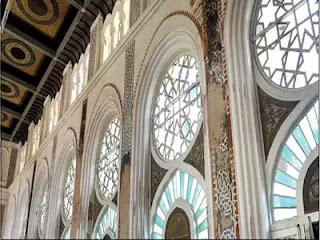 |
| Madras Univ. Senate House, Chennai. upload.wikimedia.org |
The 140 year old Senate building was the brain child of Gov. Lord Napier who wanted to have a beautiful senate building built that would surpass the splendor of inspiring architecture of some of the Bombay University's buildings. Designed by Indo Saracenic style by Robert Fellows Chisholm whom Napier selected through open competition, the purpose of the building was to host senate meetings and convocations of the University of Madras in a stately building, Madras Univ. was one of the earliest Indian universities established by the Raj under the direct Crown administration after 1858 in the wake of the Great rebellion. The purpose was to produce Indian graduates and employ them for cheap salaries.
 |
| Madras Univ. Senate House, Chennai Alamy.com |
 |
| Madras Univ. Senate House, Chennai. upload.wikimedia.org |
 |
| Madras Univ. Senate House, Chennai. upload.wikimedia.org |
 |
| Madras Univ. Senate House, Chennai. upload.wikimedia.org |
 |
| Madras Univ. Senate House, hall.Chennai.thenewsminute.com+ |
 |
| Madras Univ. Senate House, Chennai. upload.wikimedia.org |
Built in 1879, the Senate House is on the university's Chepauk campus and this artistically rich building after restoration in 2006 was not put to proper use and it had not only fallen into disrepair but had become a resting place for poisonous creatures to roost. It is sad to note that many of the heritage structures of the university are facing similar condition - poor maintenance and negligence. Official apathy is writ all over the place . The media reports pointed out that it was not kept clean and tidy. Callowness and dereliction of duty on the part of officials are retrograde. Right before our eyes we are facing the slow decay of a wonderful colonial building which Chisholm took 5 years to build incorporating many Indian architectural elements.
I remember having visited the building in the early 1960s. it was well-kept and maintained by the authorities. So was the High Court building and the visitors were allowed to go to the top of the light house and from the balcony right below the revolving light chamber one could see a fine vista of the city all around. This awe-inspiring early colonial building housed administrative departments of the University and offices of the Vice-Chancellor as well as the Registrar of the University of Madras.
No doubt, now exterior parts look nice. What about interior parts? Because of keeping it vacant for a long period and poor upkeep, the building is back on deteriorating mode that results in torn false ceiling in some places, water seepage during rains, peeling of paint on the interior walls and plaster crumbling from the walls, etc. The Senate hall was used once in a while for senate meeting and seminar and part of it as a storage space for exam papers. Because the acoustics might damage the windows that they are always kept closed.
 |
| Madras Univ. Senate House, Chennaisriramv.wordpress.com |
 |
| Madras Univ. Senate House, Chennai. indiatimes.com |
After 2 long year's work the Senate House was restored in September 2006 and opened by the Late Dr. Abdul Kalam, President of India. Later for various reasons it remained unused for a decade or so. INTACH and ASI played a crucial role in the restoration of the structure and in the choice of construction materials, fresco painting, murals, stained glass windows, etc., to retain the old heritage value and the aesthetics. Recreation of old-type plaster for the wall was a challenging one. The team took up the challenge and used traditional building materials like nutmeg, jaggery, milk, egg, coconut shell, curd, sand, etc. For art work and stained glass work they used natural colors. As for wood they used Burma teakwood that was widely used in the colonial period.
Reusing the renovated building is the best way to preserve it, but too many foot falls would damage the structure with heritage value. So, it is essential to avoid public meetings. In 2007 and later some addition restoration work was carried out through the efforts of the then VC. This early colonial premier institution in 2008 had celebrated its 150th Anniversary. The authorities must be transparent about the use of restored Senate House and its periodic maintenance. Taking care of such a well-decorated colonial building is a tough job but it can be eased by forming a Maintenance Committee to take care of the Senate building on a regular basis. In August 2015 PM Modiji inaugurated ''the National Handloom day'' at the Senate House. In 2019 there was a conference on photography.
The longer the Senate House remained unused, the more damage it might suffer in the future, So, the university authorities must take extra caution and see to it the famous Senate House's past glory is retained regularly. It is to be assumed that the university officials had either the expertise or an iota of interest to keep the structure in good nick, not withstanding the fact so much money had been spent on its restoration work. There were complaints that the interior wall plastering and paint showed signs of fading and degradation. There was no proper cleaning of the floors, etc., as evidenced by bird drooping. Despite the glitter on one hand, poor upkeep and hurried restoration work by the contractors show the landmark building of Chennai in poor light.
We have to be true to the heritage left behind by our forefathers because the cultural continuity has to remain unbroken.
https://en.wikipedia.org/wiki/Senate_House_(University_of_Madras)
http://www.ptkarch.com/projects/senate-house-chennai-an-intach-chennai-project/









